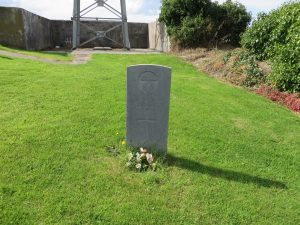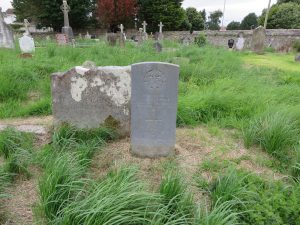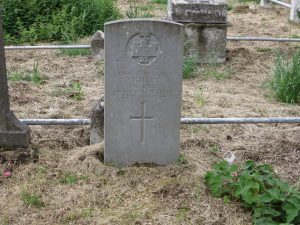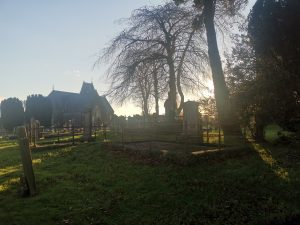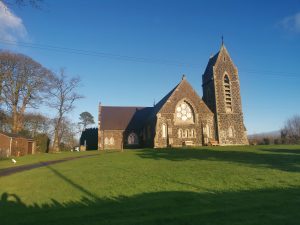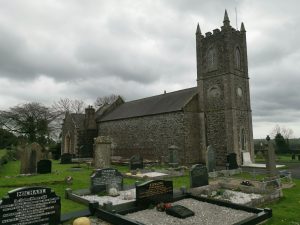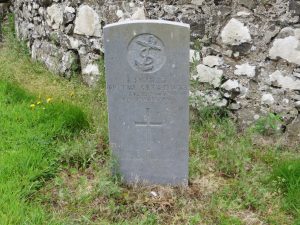Sweeney, J (John)

Sweeney, J (John)
Private John Sweeney was the son of Mrs. Margaret (Maggie) Sweeney, of 2, Connell St., Limavady, Co. Londonderry.
John arrived with the 2nd Battalion in France on the 23rd of August 1914 and went straight to Bertry[1] where they de-trained on the 25th (early in the morning). Within 14 hours they were involved in small skirmishes with the Germans, and so began their war and a fighting retreat.
The battalion moved positions many times and saw no real action or heavy casualties until the 1st of September at Verberie[2] and then on the 7th at Villiers[3]. September would see their casualty list slowly growing daily, but they were soon gaining the upper hand and crossed the river Aisne on pontoons on the 13th while pursuing the Germans who were retreating.
That night they continued up a narrow plateau towards the Germans under cover of fog, but the sun appeared, the fog cleared, and the Germans were waiting. The machineguns ripped through the attackers causing massive casualties. The battalion then retreated across the river Aisne to safety and advanced on the village of Sainte-Marguerite [4] where they took up defensive positions while being constantly snipped at and shelled by the Germans. Here they remained under the same conditions until the 7th of October, when they withdrew at 1:15 am under the cover of darkness travelling to Longueil by the means of route marches, train, and motor vehicle via Septmonts and Chacrise.
The battalion left Longueil after getting 4 hours rest in billets at 10:50 am on the 13th towards Méteren,[5] but the village had been taken during the night by the Germans after fierce fighting. After a brief skirmish with the enemy and receiving 3 casualties, the village was once again in British control. They buried 14 Germans and left again towards Ploegsteert[6] which they found to be occupied by the 9th Queen’s Royal Lancers of the 2nd Calvary Brigade. Together they pushed towards Le Gheer[7] but were heavily shelled.[8] The calvary battalion suffered terribly. The 2nd Inniskilling Fusiliers withdrew to Houplines. The following day, on the 20th of October they returned to Le Gheer.
While in trenches outside Le Gheer, the Germans attacked again at 7:00 in the morning and continued to press their advantage until 6:00 in the evening. They now occupied all the forward trenches of the Inniskillings who had to retreat a few hundred yards while receiving 22 casualties.
The men were able to hold the new line until after 12:20 in the afternoon of the 21st, when they managed to regain their lost positions. At 22:00 hours the battalion was withdrawn to billets in Ploegsteert. Another 155 men and officers were either wounded, dead or missing.
After resting a few days, the Inniskillings moved to billets and trenches at Armentieres. On the 27th they repulsed an attack by the Germans.[9] The battlefield was littered with the German dead.
On the 30th the battalion returned to Ploegsteert, except for “A” Company who went to Messines. The latter being involved in heavy fighting on the 31st of October and 1st November in that area. Thirty-three more casualties were inflicted on the 2nd Inniskilling. Under cover of darkness, they withdrew to the second line of trenches, which was located around one mile to the south.
Whilst at the 2nd line, “A” company received a further 8 casualties, before departing to Ploegsteert to assault trenches recently lost to the Germans. Unfortunately, their attacks were repulsed, and a further 101 casualties were reported over the next few days. By the 12th, the battalion was ordered to withdraw to Le Bizet to help build trenches and support and then onto Nieppe[10] for baths and a change of clothes on the 20th. Between Nieppe and building trenches in Le Bizet the battalion would remain here until early December.
On the 8th of December 1914, the 2nd Battalion, were billeted in a convent in Wisques, France.[11] The battalion remained here in reserve to be re-equipped and to receive replacement until the 25th of January 1915 when they were ordered to join the 5th Brigade at Robecq.[12] They did this before moving onto Les Choquaux,[13] and finally, into the trenches at Festubert Les Plantin[14] by the 6th of February.
Now the battalion began a routine of repairing and building defences, whilst the French bombarded the Germans who naturally replied in kind. Snipers were now the men’s main worry, but by the end of the month they had suffered very few casualties. The month ended with them moving to the trenches at Les Choquaux,[15] and being billeted in Bethune.[16] Casualties here began to grow daily, and by the end of the month they had in total 42 men killed or wounded. Luckily though April would be much quieter with only 2 killed and 7 wounded for the entire month. The good times had come to an end.
May 1915, began in Bethune, in billets. The 2nd Battalion received only 10 casualties whilst there and by the 9th they were on the move again, this time to Richebourg.[17] They went to the line and positioned in breastworks.[18]
On the evening of the 15th, they attacked from the breastworks and although they had some gains and captured trenches, most were given up by the evening of the 16th.
Casualties of this assault were extremely high, 668 men killed, wounded, or missing. This event was later called the Defence of Festubert. All land gained was consolidated by the 26th of the same month. A few days later the battalion moved to billets at Vermelles[19] and remained in this area throughout June, which was a noticeably quiet month. Only 19 men were wounded during that period. Private John Sweeney was one of them when he was reported wounded on the 23rd of June 1915 while working on trenches for a new front line. He died of these wounds less than a month later and his body was returned home for burial.
Date of Death: 05/07/1915 (Aged 30)
Service: Private, 2nd Battalion, Royal Inniskilling Fusiliers
Service Number: 9572
Burial Location: On road boundary, Roe Mill (Saint Canice’s) Roman Catholic Burial Ground
[1] Bertry is an area in northern France.
[2] The 2nd Inniskilling Fusiliers suffered 52 casualties.
[3] The 2nd Inniskilling Fusiliers suffered 28 casualties.
[4] The village of Sainte-Marguerite-sur-Mer is a small village located north of France.
[5] Méteren is a commune in the Nord department in northern France.
[6] Ploegsteert is a village in Belgium, 1.2 miles from the French border, during late 1914 and early 1915, the nearby Ploegsteert Wood was the site of fierce fighting.
[7] Le Gheer is a small hamlet approximately 15 km south of Ypres.
[8] The 2nd Inniskilling Fusiliers suffered 22 casualties.
[9] The 2nd Inniskilling Fusiliers received 16 more casualties within 1 hour.
[10] Nieppe is around 3 miles south of Ploegsteert and is in Northern France.
[11] Wisques is an area in Western France, close to the port of Calais.
[12] Robecq is around 21 miles southeast of Wisques.
[13] Les Choquaux is around 5 miles southeast of Robecq.
[14] Festubert Les Plantin is around 10 miles east of Les Choquaux.
[15] Les Choquaux is around 6 miles southeast of Festubert Les Plantin.
[16] Bethune is around 6 miles to the west of Les Choquaux.
[17] Richebourg is an area in northern France, close to the border of Belgium, around 30 miles south of Ypres.
[18] Breastworks: A breastwork is a temporary fortification, often an earthwork thrown up to breast height.
[19] Vermelles is about 8 miles south of Richebourg.
